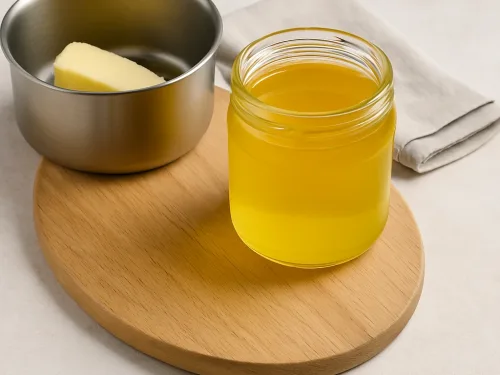Materiaal
- Methode 1
- kom heat resistant, matching the cooking pot
- bewaarkom for the clarified butter
- zeer fijn zeefje optional
- Methode 2
- bewaarkom for the clarified butter
- zeer fijn zeefje optional
Ingredients
- 500 g butter (unsalted)
Instructions
Method 1: Au bain-marie
- Use a saucepan to bring water to a boil.
- Find a suitable bowl that fits on top of the saucepan (but not in direct contact with the boiling water).
- When the water boils, turn the heat to minimum (or off). Wait for the boiling to stop, then place the bowl of butter on top.
- Give the butter time to melt. Do not stir!
- You can clearly see that the butter divides into a layer of clarified butter and a layer of milk solids. At the top you can also see some milk solids you can remove the with a spoon.
- Once the butter is completely melted and the milk solids are at the bottom, you can carefully pour over the clarified butter. For extra clean results, you can use a fine strainer but it is not necessary.
- We no longer need the remaining protein.
- Your clarified butter is now ready to use. Store it in the refrigerator; this way it will keep for several weeks.
Method 2: On a very low heat
- Put the butter in a saucepan. Dicing is not necessary if you take your time.
- Put the pan on the very lowest heat.
- Give the butter time to melt gently. Do not stir!
- You can clearly see that the butter divides into a layer of clarified butter and a layer of egg whites. At the top you can also see some milk solids you can remove the can with a spoon.
- Once the butter is completely melted and the milk solids are at the bottom, you can carefully pour over the clarified butter. For extra clean results, you can use a fine strainer but it is not necessary.
- We no longer need the remaining protein.
- Your clarified butter is now ready to use. Store it in the refrigerator; this way it will keep for several weeks.
Tips & Tricks
- Clarified butter will keep in the refrigerator for up to 2-3 months.
- Clarified butter burns less quickly because the proteins and milk components have been removed.
- You retain that typical butter flavor, but without the risk of burning.
- Ideal for Flemish-style asparagus, for searing meat or as a base for sauces.
- Stirring is not necessary and even advisable, this way the layers remain nicely separated.
- You can incorporate the leftover milk into purees or sauces for extra flavor.
- The softer the fire, the nicer the separation between the layers.
- Preferably use unsalted butter for the purest flavor.
Applications
- With asparagus Flemish-style: indispensable for the classic finish.
- For high temperature cooking of meat or fish.
- In sauce Béarnaise or Hollandaise sauce as a flavorful fat.
